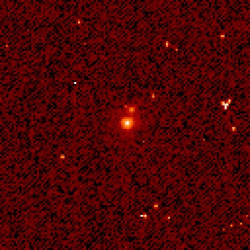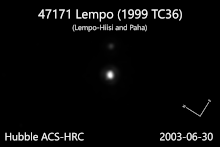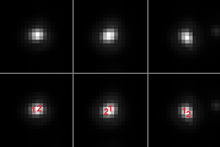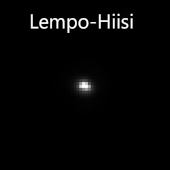47171 Lempo
47171 Lempo, or as a binary (47171) Lempo–Hiisi (also known as 1999 TC36), is a trans-Neptunian object and trinary system from the Kuiper belt, located in the outermost regions of the Solar System. It was discovered on 1 October 1999, by American astronomers Eric Rubenstein and Louis-Gregory Strolger during an observing run at Kitt Peak National Observatory in Arizona, United States.[1][11] Rubenstein was searching images taken by Strolger as part of the Low-Z Supernova Search program. It is classified as a plutino with a 2:3 mean-motion resonance with Neptune,[3] and, currently only being 30.5 AU from the Sun,[10] is among the brighter TNOs. It reached perihelion in July 2015. This minor planet was named after Lempo from Finnish mythology.[1]
 Lempo-Hiisi and their outer companion Paha, imaged with the Hubble Space Telescope in 2001. Lempo and Hiisi are not resolved in this image. | |
| Discovery | |
|---|---|
| Discovered by | E. P. Rubenstein L.-G. Strolger |
| Discovery site | Kitt Peak National Obs. |
| Discovery date | 1 October 1999 |
| Designations | |
| (47171) Lempo | |
| Pronunciation | /ˈlɛmpoʊ/ |
Named after | Lempo (Finnish mythology) [1] |
| 1999 TC36 | |
| TNO [2] · plutino [3][4] distant [1] | |
| Orbital characteristics [2] | |
| Epoch 31 May 2020 (JD 2459000.5) | |
| Uncertainty parameter 2 | |
| Observation arc | 45.46 yr (16,606 days) |
| Earliest precovery date | 18 June 1974 |
| Aphelion | 48.232 AU |
| Perihelion | 30.543 AU |
| 39.387 AU | |
| Eccentricity | 0.22456 |
| 247.20 yr (90,289 days) | |
| 7.8069° | |
| 0° 0m 14.4s / day | |
| Inclination | 8.4245° |
| 97.010° | |
| 294.394° | |
| Known satellites | Paha · S/2001 (47171) 1[5] Hiisi · S/2007 (47171) 1[5] |
| Physical characteristics | |
Mean diameter | 393.1 km (overall system)[6] 272 km (Lempo only)[5] 251 km (Hiisi only)[5] 132 km (Paha only)[5] |
| Mass | (12.75±0.06)×1018 kg (overall system)[7] (14.20±0.05)×1018 kg (without Paha)[7] 6.71×1018 kg (Lempo only).[8] |
Mean density | 0.64 g/cm3[6] |
| 6.21±0.02 h[9] | |
| 0.079[6] | |
| B–V = 1.00±0.13 V−R = 0.70±0.03[6] | |
| 19.8[10] | |
| 5.41±0.10[6] 4.8 (system)[2] | |
The trinary system's other two components, Paha /ˈpɑːhɑː/ and Hiisi /ˈhiːsi/, were discovered in 2001 and 2007, respectively, and later named after Lempo's two demon cohorts, Paha and Hiisi.[5]
Physical characteristics
The combined observations by the infrared Spitzer Space Telescope,[12] Herschel Space Telescope[6] and the Hubble Space Telescope (HST) make it possible to estimate the sizes of the system's components and consequently provide the range of possible values for the objects’ bulk density.[7] The single-body diameter (effective system size) of Lempo is currently estimated at 393.1+25.2
−26.8 km.[6]
The very low estimated density of 0.3–0.8 g/cm3 obtained in 2006 (when the system was thought to be a binary) would require an unusually high porosity of 50–75%, assuming an equal mixture of rock and ice.[12] The direct measurement of visible fluxes of all three components of the system in 2009 by the HST has resulted in an improved average density of 0.532+0.317
−0.211 g/cm3 confirming the earlier conclusion that the object is probably a rubble pile.[7] The density was revised up to 0.64+0.15
−0.11 g/cm3 in 2012 when new information from the Herschel became available. For a bulk density in the range 1–2 g/cm3 the porosity is in the range 36–68%, again confirming that the object is a rubble pile.[6]
Lempo has a very red spectral slope in visible light[13] and a flat spectrum in near infrared. There is also a weak absorption feature near the wavelength of 2 μm, probably caused by water ice. The best model reproducing the near infrared spectrum includes tholins, crystalline water ice, and serpentine as surface materials. These results are for the integrated spectrum of all three components of the system.[14]
Trinary system

Lempo is a triple system consisting of a central primary, which is itself a binary, Lempo and Hiisi, and a small satellite, Paha.[5][7]
Paha
On 8 December 2001, observations by Chadwick Trujillo and Michael Brown using the Hubble Space Telescope, revealed the presence of a minor-planet moon, provisional designation S/2001 (47171) 1, later named Paha. The discovery was announced on 10 January 2002.[15] The satellite has an estimated diameter of 132+8
−9 km[6] and a semi-major axis of 7411±12 km, orbiting its primary in 50.302±0.001 d.[7] It is estimated to only have a mass of about 7.67×1017 kg.[8]
Hiisi


In 2007, analysis of Hubble images revealed that the primary is itself a binary system composed of two similarly sized components.[7] While the first component (A1) maintained the name Lempo, the second, new component (A2), provisionally designated S/2007 (47171) 1, was later named Hiisi.
This central pair has a semi-major axis of around 867 km and a period of about 1.9 days.[7] Assuming equal albedos of about 0.079, Lempo and Hiisi are approximately 272+17
−19 km and 251+16
−17 km in diameter, respectively.[6] The earlier discovered satellite Paha orbits the barycenter of the Lempo–Hiisi system.
The system mass estimated based on the motion of Paha is (12.75±0.06)×1018 kg.[7] The orbital motion of the Lempo–Hiisi components gives somewhat a higher estimated mass of (14.20±0.05)×1018 kg. The discrepancy is probably related to unaccounted gravitational interactions of the components in a complex triple system.[7] Assuming a uniform density for all components, the mass of Hiisi itself 5.273×1018 kg.[8]
The separation between the two components is only about half the diffraction limit of Hubble, making it impossible to fully resolve the system. Instead, it appears elongated in Hubble images, revealing its binary nature.[7]
Origin
There exist two main hypotheses on how this triple system formed. The first one is a giant collision and subsequent reaccretion in the disc. The second one is gravitational capture of a third object by a preexisting binary. The similar sizes of Lempo and Hiisi favor the latter hypothesis.[7]
Exploration
Lempo was suggested as a target for New Horizons 2, a proposed twin of its namesake that would fly by Jupiter, Uranus, and up to four KBOs.[16]
Naming
This minor planet was named after Lempo from Finnish mythology. Originally worshiped as the god of love and fertility, he was later depicted as a devil, after Christianity came to Finland. Lempo brought down the hero Väinämöinen with the help of his two demon cohorts Hiisi and Paha.[1] The official naming citation was published by the Minor Planet Center on 5 October 2017 (M.P.C. 106502).[17]
References
- "47171 Lempo (1999 TC36)". Minor Planet Center. Retrieved 9 October 2017.
- "JPL Small-Body Database Browser: 47171 Lempo (1999 TC36)" (2016-12-28 last obs.). Jet Propulsion Laboratory. Retrieved 9 October 2017.
- "MPEC 2009-V05 :Distant Minor Planets (2009 NOV. 15.0 TT)". IAU Minor Planet Center. 3 November 2009. Retrieved 10 December 2009.
- Marc W. Buie (31 August 2005). "Orbit Fit and Astrometric record for 47171". SwRI (Space Science Department). Retrieved 24 July 2008.
- Johnston, Wm. Robert (8 October 2017). "Asteroids with Satellites Database – (47171) Lempo, Paha, and Hiisi". Johnston's Archive. Retrieved 21 December 2017.
- Mommert, Michael; Harris, A. W.; Kiss, C.; Pál, A.; Santos-Sanz, P.; Stansberry, J.; Delsanti, A.; Vilenius, E.; Müller, T. G.; Peixinho, N.; Lellouch, E.; Szalai, N.; Henry, F.; Duffard, R.; Fornasier, S.; Hartogh, P.; Mueller, M.; Ortiz, J. L.; Protopapa, S.; Rengel, M.; Thirouin, A. (May 2012). "TNOs are cool: A survey of the trans-Neptunian region—V. Physical characterization of 18 Plutinos using Herschel-PACS observations". Astronomy & Astrophysics. 541: A93. arXiv:1202.3657. Bibcode:2012A&A...541A..93M. doi:10.1051/0004-6361/201118562.
- Benecchi, S.D; Noll, K. S.; Grundy, W. M.; Levison, H. F. (2010). "(47171) 1999 TC36, A Transneptunian Triple". Icarus. 207 (2): 978–991. arXiv:0912.2074. Bibcode:2010Icar..207..978B. doi:10.1016/j.icarus.2009.12.017.
- Correia, Alexandre C. M. (May 2019). "Chaotic dynamics in the (47171) Lempo triple system". Icarus. 305: 250–261. Bibcode:2018Icar..305..250C. doi:10.1016/j.icarus.2018.01.008.
- Thirouin, A.; Knoll, K. S.; Ortiz, J. L.; Morales, N. (September 2014). "Rotational properties of the binary and non-binary populations in the Trans-Neptunian belt". Astronomy & Astrophysics. 569 (A3): 20. arXiv:1407.1214. doi:10.1051/0004-6361/201423567.
- "AstDys (47171) 1999TC36 Ephemerides". Department of Mathematics, University of Pisa, Italy. Retrieved 7 December 2009.
- "MPEC 1999-Y19 :Distant Minor Planets (1999 DEC. 21.8 UT)". IAU Minor Planet Center. 21 December 1999. Retrieved 8 May 2015.
- J. Stansberry; W. Grundy; J-L. Margot; D. Cruikshank; J. Emery; G. Rieke; D. Trilling (2006). "The Albedo, Size, and Density of Binary Kuiper Belt Object (47171) 1999 TC36". The Astrophysical Journal. 643 (1): 556–566. arXiv:astro-ph/0602316. Bibcode:2006ApJ...643..556S. doi:10.1086/502674.
- Doressoundiram, A.; Peixinho, N.; Moullet, A.; Fornasier, S.; Barucci, M. A.; Beuzit, J. -L.; Veillet, C. (2007). "The Meudon Multicolor Survey (2MS) of Centaurs and Trans-Neptunian Objects: From Visible to Infrared Colors". The Astronomical Journal. 134 (6): 2186. Bibcode:2007AJ....134.2186D. doi:10.1086/522783.
- Protopapa, S.; Alvarez-Candal, A.; et al. (2009). "ESO large program about transneptunian objects: surface variations on (47171) 1999 TC36". Astronomy and Astrophysics. 501 (1): 375–380. Bibcode:2009A&A...501..375P. doi:10.1051/0004-6361/200810572.
- "IAU Circular No. 7787". International Astronomical Union. Retrieved 6 December 2008.
- Stern, Alan; et al. "New Horizons 2" (pdf). NASA (Outer Planets Assessment Group). Retrieved 13 May 2012. parent
- "MPC/MPO/MPS Archive". Minor Planet Center. Retrieved 9 October 2017.
External links
- (47171) Lempo Precovery Images
- (47171) Lempo, A Transneptunian Triple
- 47171 Lempo at AstDyS-2, Asteroids—Dynamic Site
- 47171 Lempo at the JPL Small-Body Database
